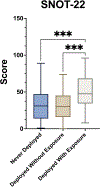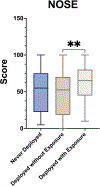Burn Pit Exposure Is Associated With Increased Sinonasal Disease
- PMID: 35673272
- PMCID: PMC9357047
- DOI: 10.1097/JOM.0000000000002551
Burn Pit Exposure Is Associated With Increased Sinonasal Disease
Abstract
Objective: The aim of this study was to determine whether self-reported burn pit exposure is associated with increased subjective and objective sinus disease.
Design: A cross-sectional study was performed evaluating consecutive adult patients presenting to a US Military rhinology clinic. Demographics, medical histories, sinonasal quality-of-life scores, and nasal endoscopy examinations were obtained. Participants were divided into three cohorts based on self-reported exposure histories and outcomes compared.
Results: One hundred eighty-six patients met the inclusion criteria, the majority of whom were male. Patients with burn pit exposure had worse Sinonasal Outcome Test-22 scores (49.9) compared with those deployed without burn pit exposure (31.8) or never deployed (31.5). Endoscopic findings demonstrated worse disease within those exposed (Lund-Kennedy score, 3.3) compared with the other cohorts (1.8 and 1.7, respectively).
Conclusions: These novel findings suggest that deployment-related burn pit exposure is associated with increased subjective and objective sinus disease.
Copyright © 2022 American College of Occupational and Environmental Medicine.
Conflict of interest statement
Funding/Conflicts of Interest: A.J.K., F.C.L., and Y.H. were supported by the National Center for Advancing Translational Sciences through grant KL2TR002490 (A.J.K.) and UL1TR002489 (F.C.L. and Y.H.). The content is solely the responsibility of the authors and does not necessarily represent the official views of the NIH. No other authors have funding or conflicts of interest.
Figures




References
-
- Tzivian L Outdoor air pollution and asthma in children. The Journal of asthma : official journal of the Association for the Care of Asthma. 2011;48(5):470–481. - PubMed
-
- Putman B, Zeig-Owens R, Singh A, et al. Risk factors for post-9/11 chronic rhinosinusitis in Fire Department of the City of New York workers. Occupational and environmental medicine. 2018;75(12):884–889. - PubMed
-
- Mady LJ, Schwarzbach HL, Moore JA, et al. Air pollutants may be environmental risk factors in chronic rhinosinusitis disease progression. Int Forum Allergy Rhinol. 2018;8(3):377–384. - PubMed
Publication types
MeSH terms
Grants and funding
LinkOut - more resources
Full Text Sources
Medical
Miscellaneous

